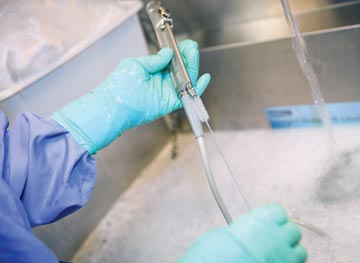As more ambulatory surgical centers perform more complex procedures, we’ve had to contend with high-profile cases of surgical site infections and defend the perception that ASCs in particular struggle to maintain compliance with infection control requirements. Adding fuel to this fire is a September 2019 Office of Inspector General (OIG) report (osmag.net/9rZDxR) that includes this indictment: “Outbreaks of healthcare-associated infections have raised concerns about patient health and safety at ASCs.” State surveyors cited 55% of non-deemed ASCs with one or more infection control deficiencies in the ASCs’ most recent certification surveys, says the OIG report, which went on to call on state regulators to conduct more frequent inspections of ASCs so such occurrences don’t continue unabated. With that as a backdrop, here are 4 things you can do to practice great infection prevention so you don’t get dinged the next time a state surveyor pays your facility a visit.
1 Stay up to date on guidelines. One of the things we find at all kinds of surgical facilities, but especially at ASCs, is that they don’t have copies of the most up-to-date standards and guidelines on hand for cleaning and sterilization, environmental cleaning and other areas of infection prevention. This is a huge detriment, because each time those guidelines are updated, it’s an opportunity for all of us to improve our practices. The Association for the Advancement of Medical Instrumentation (AAMI) standards and Association of periOperative Nurses (AORN) guidelines are the drivers for how we practice infection prevention in surgery and sterile processing. These guidelines are expensive to purchase, but well worth it. I often see people using outdated guidelines. They’re following them, and think they’re fine, then learn they’re not compliant because practices have changed. It’s critical for any ASC to have current copies of those standards and guidelines, and literally build their practices, procedures and policies around them.
2 IFUs: Learn them, love them, live them. You should also have the instructions for use (IFUs) for all the devices and equipment you use. They can’t be shelf documents, however. You have to keep an open mind that the IFU’s contents, as well as what’s in the AAMI standards and AORN guidelines, can teach you something you didn’t know. A lot of times we learn things and assume that’s how it should be done forever. You may think you know the best way to turn a room, handle a chemical, clean devices and operate equipment, but it’s the little changes that happen in increments that we need to keep on top of in order to improve our performances.
The “that’s always how we’ve done it here” mentality isn’t helpful. For example, years ago we didn’t have to follow IFUs. We just took a best-guess approach on the best way to clean a new instrument. Current processes involve more steps and take longer, but result in cleaner and safer instruments. I still get calls from people who don’t realize they have to follow IFUs. Even though it can be difficult, it’s no longer acceptable to stick with the way it’s always been done because you haven’t had any problems.
.svg?sfvrsn=be606e78_3)

.svg?sfvrsn=56b2f850_5)